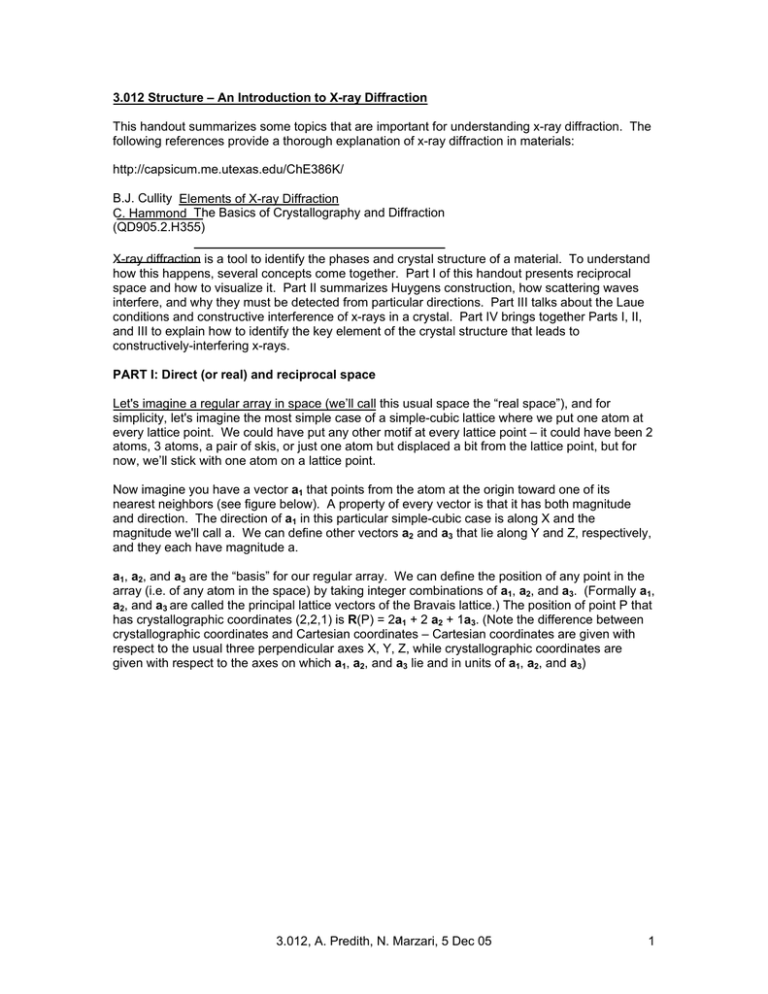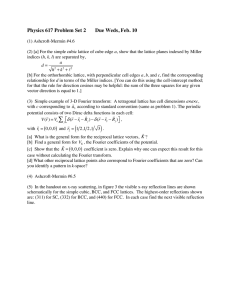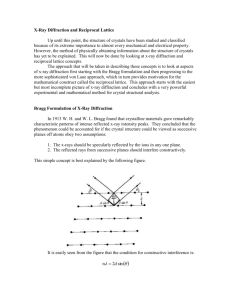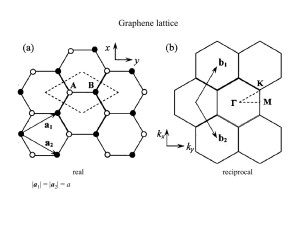3.012 Structure – An Introduction to X-ray Diffraction
advertisement

3.012 Structure – An Introduction to X-ray Diffraction This handout summarizes some topics that are important for understanding x-ray diffraction. The following references provide a thorough explanation of x-ray diffraction in materials: http://capsicum.me.utexas.edu/ChE386K/ B.J. Cullity Elements of X-ray Diffraction C. Hammond The Basics of Crystallography and Diffraction (QD905.2.H355) X-ray diffraction is a tool to identify the phases and crystal structure of a material. To understand how this happens, several concepts come together. Part I of this handout presents reciprocal space and how to visualize it. Part II summarizes Huygens construction, how scattering waves interfere, and why they must be detected from particular directions. Part III talks about the Laue conditions and constructive interference of x-rays in a crystal. Part IV brings together Parts I, II, and III to explain how to identify the key element of the crystal structure that leads to constructively-interfering x-rays. PART I: Direct (or real) and reciprocal space Let's imagine a regular array in space (we’ll call this usual space the “real space”), and for simplicity, let's imagine the most simple case of a simple-cubic lattice where we put one atom at every lattice point. We could have put any other motif at every lattice point – it could have been 2 atoms, 3 atoms, a pair of skis, or just one atom but displaced a bit from the lattice point, but for now, we’ll stick with one atom on a lattice point. Now imagine you have a vector a1 that points from the atom at the origin toward one of its nearest neighbors (see figure below). A property of every vector is that it has both magnitude and direction. The direction of a1 in this particular simple-cubic case is along X and the magnitude we'll call a. We can define other vectors a2 and a3 that lie along Y and Z, respectively, and they each have magnitude a. a1, a2, and a3 are the “basis” for our regular array. We can define the position of any point in the array (i.e. of any atom in the space) by taking integer combinations of a1, a2, and a3. (Formally a1, a2, and a3 are called the principal lattice vectors of the Bravais lattice.) The position of point P that has crystallographic coordinates (2,2,1) is R(P) = 2a1 + 2 a2 + 1a3. (Note the difference between crystallographic coordinates and Cartesian coordinates – Cartesian coordinates are given with respect to the usual three perpendicular axes X, Y, Z, while crystallographic coordinates are given with respect to the axes on which a1, a2, and a3 lie and in units of a1, a2, and a3) 3.012, A. Predith, N. Marzari, 5 Dec 05 1 Z a3 a2 a1 Y P X Figure by MIT OCW. Now let's look at the reciprocal lattice. The formal definition is that the reciprocal lattice vector G belongs to the reciprocal lattice of a Bravais lattice if the plane wave exp(i G • r) has the same amplitude at every point of the direct Bravais lattice of which G is a reciprocal lattice vector. In practice, this is how you can think at it: we define a basis in the reciprocal space in terms of three principal lattice vectors b1, b2, and b3 : b1 = 2π * (a2 x a3) / V, where V = a1 • (a2 x a3) b2 = 2π * (a3 x a1) / V b3 = 2π * (a1 x a2) / V Note that the scalar product between ai and bj will be 2π if i=j, or 0 otherwise. The units of reciprocal space are 1/distance (1/Å, for example). As any direct Bravais lattice vector can be defined by integer combinations of a1, a2, and a3, similarly, any reciprocal lattice vector can be defined by integer combinations of b1, b2, and b3. Combinations of b1, b2, and b3 create a regular array of points, and the points form a lattice in reciprocal space. b1, b2, and b3 are called the reciprocal lattice basis vectors. If you change the direct lattice (e.g. making the basis vectors longer), the reciprocal lattice vectors will change in an inverse way (e.g. becoming shorter). On the other hand, the scalar product between a direct lattice vector that has crystallographic coordinates (p,q,r) and a reciprocal lattice vector that has coordinates (s,t,u) will not change (think about this, and use the scalar product above). PART II: Huygen’s construction Now let's talk about diffraction. This topic is nicely covered in the handwritten notes "Description and Determination of Atomic Positions in Crystalline Solids." Please read those notes to fully understand the material. Part II and Part III gives a brief summary. When x-rays (λ ~1 Å) impinge on a materials, the atoms scatter the x-rays because the distance between atoms is about the same size as the x-ray wavelength. Huygens construction shows what happens when a plane wave (an x-ray, for example) hits a regular array of scatterers (a row of atoms, for example). In the 'Normal Incidence' figure on page 6 of the notes and in the figure below, consider an arc with the smallest radius next to a single scatterer. The arc represents where the wave has equal amplitude or is at the same phase. The next largest arc shows the same amplitude when the wave is one wavelength farther away from the scatterer. 3.012, A. Predith, N. Marzari, 5 Dec 05 2 (Left-pointing 1st, 2nd, and 3rd order, and all higher order beams not shown.) 0th Order 1st Order 2nd Order 3rd Order Groove Incident Plane Wave (Lambda = 2/11 * Grating Pitch) Diffraction Grating Figure by MIT OCW. When viewed from very far away and from a few very specific directions, however, it is possible to see x-rays from different scatterers all with the same amplitude; the x-rays are in phase. In fact, if you look at the array of scatterers from far away (using your x-ray vision) from a direction perpendicular to the scatterers (you're looking at them head-on), the x-rays from all the scatterers will have the same amplitude. This is the zero-order direction. If you look at the scatterers from a direction perpendicular to the 'first-order' tangent, you will see when the scattered waves on that tangent are in phase. The same holds true for 'second-order', 'third-order' and so on. The purpose of Huygens construction is to show that it is possible to see waves in phase coming from different scatteres only when you look at the scatterers from very specific directions. It is also important to notice that when viewed at a great distance, the individual waves in phase with each other appear like plane waves. The wavefront becomes flat at large distances. Notice that different combinations of scatterers contribute to each order of in-phase wavefronts. PART III: Laue conditions Laue took a step further to quantify what is necessary for constructive interference of x-rays when they’re scattered by atoms. Using the model of a single chain of atoms in 3-D space, the difference between the 'extra' distance travelled by one incoming wave and the 'extra' distance travelled by the other outgoing wave must be an integer number of wavelengths. See page 9 of the notes and the figure below. This condition must be true if we have a crystal (instead of a row of atoms) in all three directions of the direct Bravais lattice, and the conditions give rise to the Laue equations: a • (S-So) = nxλ b • (S-So) = nyλ c • (S-So) = nzλ 3.012, A. Predith, N. Marzari, 5 Dec 05 3 S0 a.S0 a.S a S Figure by MIT OCW. S and So are vectors that describe the direction of the waves and they have norm = 1. So, if we have only a chain of atoms, the diffracted waves off the chain will be seen at several angles, and since there is rotational symmetry around the chain, we will see the diffracted beams form several different cones – the allowed angles for these cones will correspond to angles for which the first Laue condition above holds. If you now imagine chains of atoms in all three dimensions (that’s what a crystal is) with x-rays scattering off each chain, you can imagine cones originating from chains along each of the three crystallographic directions. Sadly, most of these cones will interfere with each other, and only if you look at the intersection (if there is one) between one of the cones in one direction, one of the cones in the second direction, and one of the cones in the third directions, you’ll see some light (i.e. a plane-wave beam, in phase). To make clear what is happening, let's define some distances. If you imagine one atom at the origin, the distance between the origin and the next atom in one chain is 'a', the distance between the origin and the next atom in another chain is 'b', and the distance between the origin and the next atom in a third chain is 'c'. The distances a, b, and c are each important for constructive interference along each chain, as we saw previously. But what about in three dimensions when all cones from all the chains are interacting? What constructive interference must the chains have in common to define the intersection of the cones? One way to look at this is via the Laue equations written above – you need to be in a direction S such that the change with respect to S0 has led to an additional integer number of wavelengths to have been traveled by the ray hitting you. Figure by MIT OCW. An alternative picture was given by Bragg. If you look at the atoms at the endpoints between the origin and a, the origin and b, and the origin and c, those three atoms define a plane. The 3.012, A. Predith, N. Marzari, 5 Dec 05 4 distance between the atoms in that plane and the atoms in the next nearest parallel plane must also contain an integer number of wavelengths for constructive interference to happen. The letter d denotes the distance between two parallel planes. The intersection of the cones represent xrays that have direction along the perpendicular distance d between two planes and that have an integer number of wavelengths along d. Those vectors are beams of x-rays that can be detected in real space when the x-ray diffraction experiment takes place. Notice that the constructive interference depends on the ratio between λ and d. The explanation of reflecting planes in the description of Bragg’s Law does not provide an accurate physical picture of what actually occurs in x-ray diffraction. The resulting Bragg equation nλ = 2dsinθ is, however, a useful tool for calculating the distances between planes (d) that give rise to diffraction given an angle of incidence (or measurement) and an incoming x-ray wavelength. PART IV: Ewald construction In Part I of this handout, we talked about defining reciprocal space vectors from a real space lattice. Now let's say that those vectors in reciprocal space vectors are actually vectors defining the propagation directions of x-rays that are scattering off the atoms. From Part III we showed that the x-rays that constructively interfere in three dimensions will depend on the wavelength and the distance d between planes. Now, if an experiment to determine a crystal structure uses a monochromatic x-ray source, all the x-rays will have one wavelength λ . Ewald's construction gives a geometrical interpretation of the Laue conditions in 3D. Define the incoming and scattered x-rays on to a crystal with vectors of length 2π/λ and with directions So and S. Just as the Laue condition states, constructive interference occurs when the difference between the incoming and diffracted vectors gives a vector that is an integer number of wavelengths. The resulting vector that is the difference between the incoming and diffracted vectors is called d*. It's length is 2π/λ (So and S are versors, i.e. they have norm=1). Diffracted beam hkl hkl d* 2π S λ hkl P = S-S0 2π d* hkl λ θ Incident beam 2π/λ θ C θ 2π S λ 0 Crystal at the center of the sphere O Origin of the reciprocal lattice Reflecting sphere Figure by MIT OCW. Now consider if we plot this vector d* in reciprocal space such that d* goes from the origin O to the point P (see graph above), We have also drawn the Ewald sphere, of radius 2π/λ, such that it goes through O. Now, Laue conditions ask that the vector d* has integer crystallographic coordinates in reciprocal space. You can see that this is in general very unlikely, but it will happen 3.012, A. Predith, N. Marzari, 5 Dec 05 5 if we start changing continuously λ (as in the picture below), or if we rotate the crystal, for a fixed λ. 202 201 Reflected Beam Incident Beam 102 201 200 200 Reflected 201 Beam 201 Reflected Beam 202 Reflecting Sphere for Smallest Wavelength 002 001 101 100 2π/λmax 000 2π/λmin 101 001 102 002 Reflecting Sphere for Largest Wavelength Figure by MIT OCW. When carrying out an XRD experiment, you may use a "white" spectrum of radiation (that is, you use many wavelengths of radiation). With many wavelengths, spheres of many radii are plotted on the reciprocal lattice and any reciprocal lattice point that crosses the spheres will constructively interfere. The other possibility is to use monochromatic wavelengths but with a powder of crystals, so that the reciprocal spaces of all the crystallites are oriented in all possible positions. This is the Debye Scherrer experiment that shows how measuring the angles of the resulting x-ray beams tells us what peaks are diffracting in a material for a given wavelength. Figure by MIT OCW. 3.012, A. Predith, N. Marzari, 5 Dec 05 6






